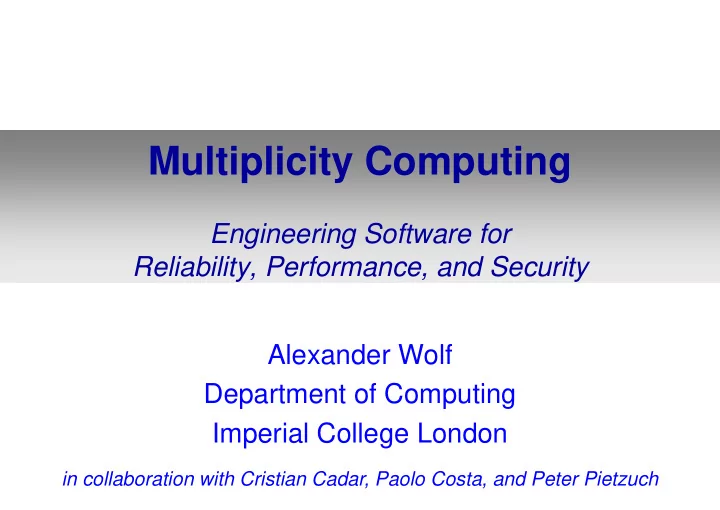

Multiplicity Computing Engineering Software for Reliability, Performance, and Security Alexander Wolf Department of Computing Imperial College London in collaboration with Cristian Cadar, Paolo Costa, and Peter Pietzuch
An inspiring example Solving “hard” computational problems Idea: run multiple instances of a SAT solver, each using a different parameter setting MiniSAT [Bordeaux et al., 2009]; ManySAT [Hamadi et al., 2009] Result: 128-core MiniSAT solves 55% more problems Result: ManySAT wins parallel SAT track at SAT-Race 2008 and SAT-Competition 2009 from Bordeaux et al., 2009
Another inspiring example Improving reliability Idea: “speculate” execution in different environments roll back on error; rerun in modified environment Rx [Qin et al., 2007] Result: certain hidden faults avoided in MySQL, Apache, CVS, ... from Qin et al., 2007
Yet another inspiring example Avoiding memory exploits Idea: obfuscate addresses by randomizing memory layout in execution stack [Bhatkar et al., 2003] Result: success in defending against many kinds of buffer overflow attacks from Bhatkar et al., 2003
What do we learn from these examples? Improvement achieved through diversity Good behaviors can emerge from randomness Run-time techniques sometimes better than design-time techniques Good choices are situated in context of use Sometimes easier to detect good/bad behaviors than to predict them Opportunity to exploit parallelism for non- parallel applications
An uninspiring example N-version programming Idea: programmers independently design/build to same spec, thereby avoiding common-mode failures [Chen and Avizienis, 1977] Result: shown to work in some special cases, but in general fails to achieve statistical independence [Knight and Levenson, 1986] from Chen and Avizienis, 1977 (reprinted 1995)
What do we learn from this example? Need much richer sources of diversity Need to automate creation of variants Need good understanding of statistical properties of variants Need some sort of specification or other source for constructing oracles
Multiplicity computing Cadar, Pietzuch, and Wolf, 2010 Tools, techniques, architectures, and languages for exploiting and managing diversity-based system execution design issues execution issues – finding exploitable diversity – run-time infrastructure for managing and executing – automated creation of variants variants – platform for managing – design methods and resources architectures
Many potential sources of diversity Code Environment Code mutations Configuration parameters Data structure choice Communication topologies Library choice Scheduling Peep-hole transformations Memory layout GA transformations Garbage collection Symbolic execution Message re-orderings Computational precision Time delays
Resources are not the issue multiplicity of computation, communication, and storage credit:: Passion Pictures (UK) http://www.passion-pictures.com/
So what are the issues? Automatically generating variants Understanding statistical properties Managing lifetimes Managing resources Managing state, side effects, and interactions Developing reliability, performance, and security oracles Giving illusion of a single instance, even when multiple variants are executed (a “virtual app”)
What are some applications? Staged deployment In vivo (in situ?) experimentation/testing Optimal (parameter) tuning Patch selection/validation High-level speculative execution
Summing up Multiplicity computing continues shift of software engineering from a development-time activity to a run-time activity From absolute properties to “propabilities” Parallel execution for the other 99% Requires contributions from many disciplines – traditional and search-based software engineering, distributed middleware and operating systems, programming languages and run-time systems, evolutionary programming, ...
Recommend
More recommend